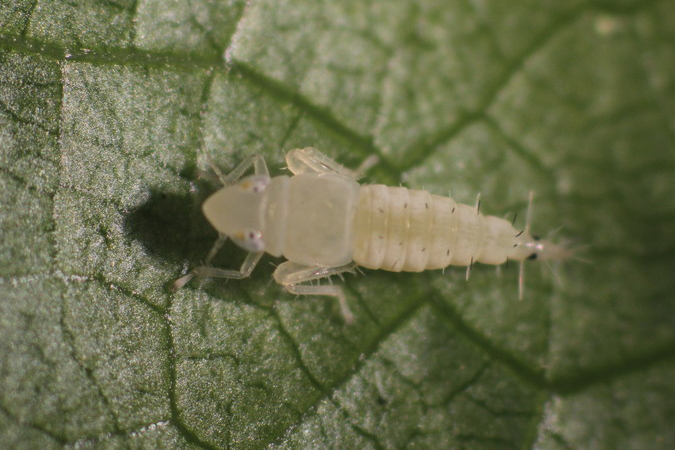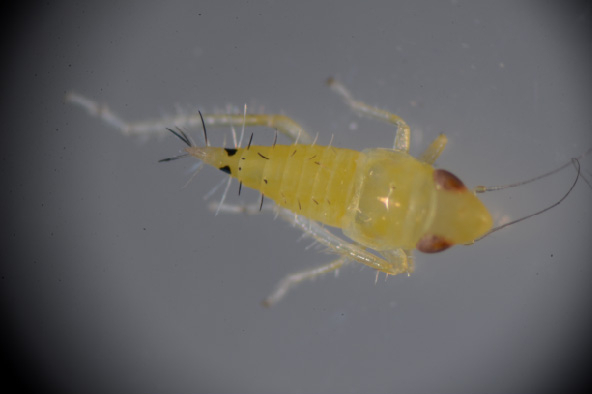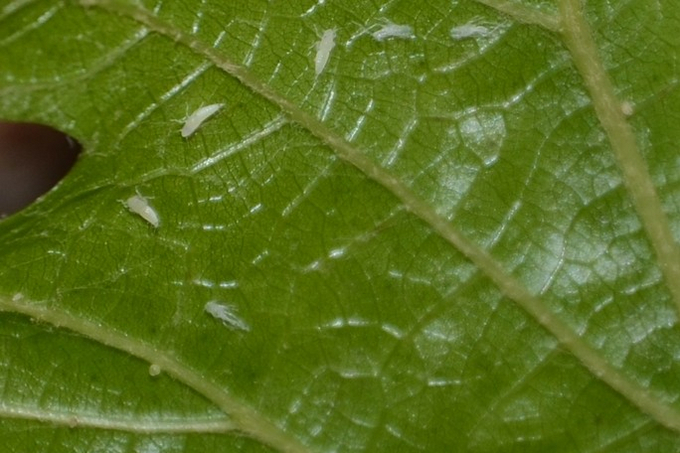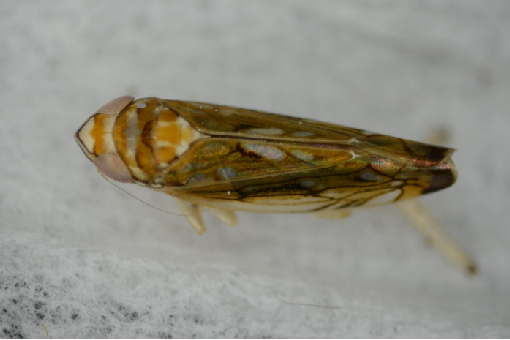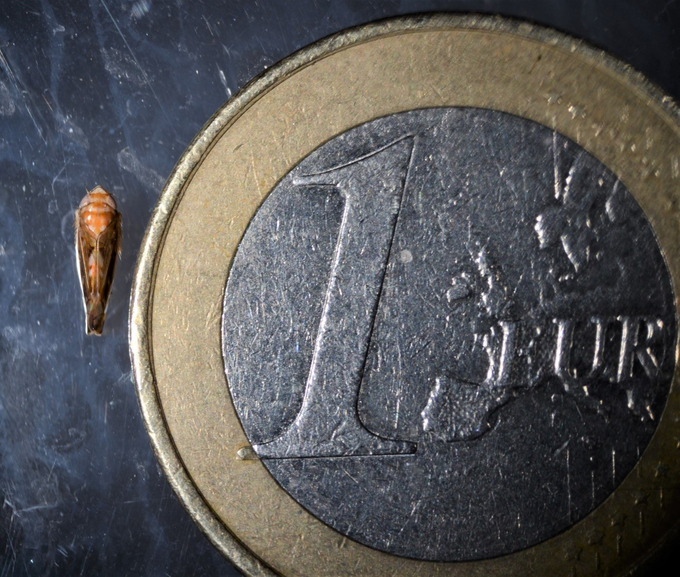American grapevine leafhopper
Scaphoideus titanus
Appearance
The adult American vine cicada(Scaphoideus titanus) is winged and 5-6 mm long. Its distinctive features are its pointed head shape, medium brown bands on the back and the contrastingly coloured wings, which have white spots and dark wing veins.
The first larval stage is about 1.8 mm in size and translucent white in colour. There are two dark spots at the end of the body. The other four larval stages also show these two dots. With each moult, the larvae become larger and their body colour darker.
Biology
In Austria, the first larvae begin to hatch around the last week of May. Hatching is influenced by the weather, geographical location and altitude of the vineyards and takes several weeks, so that different developmental stages occur simultaneously. The young larvae are often attached to the cane shoots on the underside of the leaves. After a total of five larval stages, the adult, flight-capable cicadas emerge in July. Beginning in late July, the females lay their eggs on the vine under the bark. The American grapevine cicada survives the winter in the egg stage. It goes through one generation a year.
Damage symptoms
In itself, the American grapevine cicada is not a pest. However, it transmits the pathogen of the economically important golden yellowing of the vine (flavescence dorée). These are phytoplasmas that live as cell parasites in the sieve tubes of the vine. Freshly hatched larvae of the American grapevine cicada are always free of flavescence dorée phytoplasmas. If the cicadas suck on a vine infected with flavescence dorée, they ingest the pathogens with the sap flow. After three to four weeks, the cicadas can then pass on the phytoplasmas. The greatest danger with regard to the spread of golden yellowing comes from the adult cicadas. These appear from about mid-July to the end of September. Due to the close attachment of the American grapevine cicada to the vine, the disease can spread rapidly.
Host plants
The main host plant of the American grapevine cicada is the grapevine(Vitis spp), on whose phloem sap the cicadas feed and on which mating and oviposition occur. Occasionally, the American grapevine cicada also feeds on other plants when they grow near vines. For example, it has been found on the following plant species:
- Self-climbing maidenhair vine(Parthenocissus quinquefolia).
- Wicker(Salix viminalis)
- Peach(Prunus persica)
- American elm(Ulmus americana)
However, development from egg to adult cicada is only possible on grapevines.
Distribution
The American vine borer occurs in the following countries (as of 2024): France, Italy, Spain, Portugal, Switzerland, Slovenia, Croatia, Serbia, Austria, Hungary, Slovakia, Bosnia and Herzegovina, Montenegro, Romania, Bulgaria, Moldova, Czech Republic, Ukraine, Kosovo, Russia and Germany.
In Austria, it was first detected in 2004 in vineyards in south-east Styria. Since then, AGES experts have been monitoring the spread, population size and development of the American vine borer in the wine-growing regions, particularly in eastern Austria, in close co-operation with the provincial plant protection services and chambers of agriculture in order to be able to take the necessary measures in good time and prevent damage. So far, the American grapehopper has established itself in Styria, Burgenland, Lower Austria and Carinthia and occurs in varying numbers in some regions.
In 2024, the American grapehopper was monitored at a total of 108 official locations in Lower Austria, Burgenland, Styria, Carinthia and Vienna. The occurrence of the American vine borer varies greatly in the different wine-growing regions.
In 2024, very few ARZ were detected for the first time in two high-yield vineyards in Vienna. On the other hand, a sharp increase in the number of catches was recorded at several locations close to the border in the northern and eastern Weinviertel and eastern Carnuntum as well as in northern Burgenland. In Styria, the ARZ catch figures fell significantly in the 2024 season. There has been no evidence of ARZ in the Thermenregion to date.
The 2024 molecular genetic analysis of grapevine samples and American grapevine cicadas from Lower Austria and Vienna for a possible infection with the grapevine flavescence dorée phytoplasma showed that the samples were not infected. However, FD-infected ARZs were detected in 2024 at one location in southern Burgenland and in south-east Styria.
Economic importance
As an effective vector of flavescence dorée phytoplasma, the American grapevine cicada plays a central role in the epidemiology of flavescence dorée. When flavescence dorée infecting vines and many American grapevine cicadas occur simultaneously, rapid spread of the disease can occur in the viticultural area. Flavescence dorée can cause massive damage to grapevines. The consequences are yield losses, high production costs due to additional inputs or costs for uprooting and replanting. Flavescence dorée has the status of a notifiable Union quarantine disease in the European Union because of its negative impact on viticulture.
Prevention and control
To prevent the larvae from being infected with the flavescence dorée phytoplasma, it is advisable to use suitable plant protection products from the third larval stage onwards(List of plant protection products approved in Austria) .
It should be noted that the larvae hatch over several weeks. A second treatment to capture the later hatched larvae may be necessary. In principle, vector control should always be based on the surveys from monitoring and the recommendations of the relevant state plant protection service and the Chamber of Agriculture. The latest information on American grapevine cicada monitoring can be obtained from the Grapevine Protection Service or insect-watch.
In the fall, close visual inspection of the vines for yellowing symptoms is very important. In case of suspicion, a plant examination is recommended to exclude the possibility of confusion with other causes of yellowing (e.g.: stolbur). Because only if the sources of infection are quickly removed, the spread of golden yellowing of the vine can be prevented.
Specialized information
Publications
Götsch, D., Strauß, G., Blümel, S., 2020. Laboratory trials to reduce egg hatching of the American grapevine leafhopper (Scaphoideus titanus) with selected insecticides; Bulletin of Insectology, 73(1), 53-58. ISSN: 1721-8861 (Print); 2283-0332 (Online).
Strauss, G., Reisenzein, H., 2018. First detection of Flavescence dorée phytoplasma in Phlogotettix cyclops (Hemiptera, Cicadellidae) and considerations on its possible role as vector in Austrian vineyards. Integrated Protection in Viticulture IOBC-WPRS Bulletin, 139, 12-21.
Kopacka, I., Steffek, R., Strauß, G., Reisenzein, H., 2017. Modeling spatial and temporal spread of Flavescence dorée in two Austrian vine growing areas. IOBC-WPRS Bulletin, 128, 66-74.
EFSA Panel on Plant Health (PLH), Jeger, M., Bragard, C., Caffier, D., Candresse, T., Chatzivassiliou, E., Dehnen-Schmutz, K., Gilioli, G., Jaques, J. A., MacLeod, A., Navajas, M., Niere, B., Parnell, S., Potting, R., Rafoss, T., Urek, G., Rossi, V., Van Bruggen, A., Van Der Werf, W., West, J., Winter, S., Bosco, D., Foissac, X., Strauss, G., Hollo, G., Mosbach-Schulz, O., Gregoire, J-C., 2016. Scientific opinion on the risk to plant health of Flavescence doree for the EU territory. EFSA Journal, 14(12). doi:10.2903/j.efsa.2016.4603
Strauß, G., Reisenzein, H., Steffek, R., Schwarz, M., 2014. The role of grapevine arbours as overlooked sources of „flavescence dorée” and Scaphoideus titanus in southeastern vineyards of Austria. In: Bertaccini, A. (Ed.), Phytoplasmas and phytoplasma disease management: how to reduce their economic impact. IPWG – International Phytoplasmologist Working Group, 239-245.
Steffek, R., Reisenzein, H., Strauss, G., Leichtfried, T., Hofrichter, J., Kopacka, I., Schwarz, M., Pusterhofer, J., Biedermann, R., Renner, W., Klement, J., Luttenberger, W., Welzl, A.G., Kleissner, A., Alt, R., 2011. VitisCLIM, a project modelling spread and economic impact of Grapevine Flavescence dorée phytoplasma in Austrian viticulture under a climate change scenario. Bulletin of Insectology 64, 191-192.
Last updated: 07.08.2025
automatically translated
